Omnichannel Retail Marketing: What It Is & Best Practices for Success
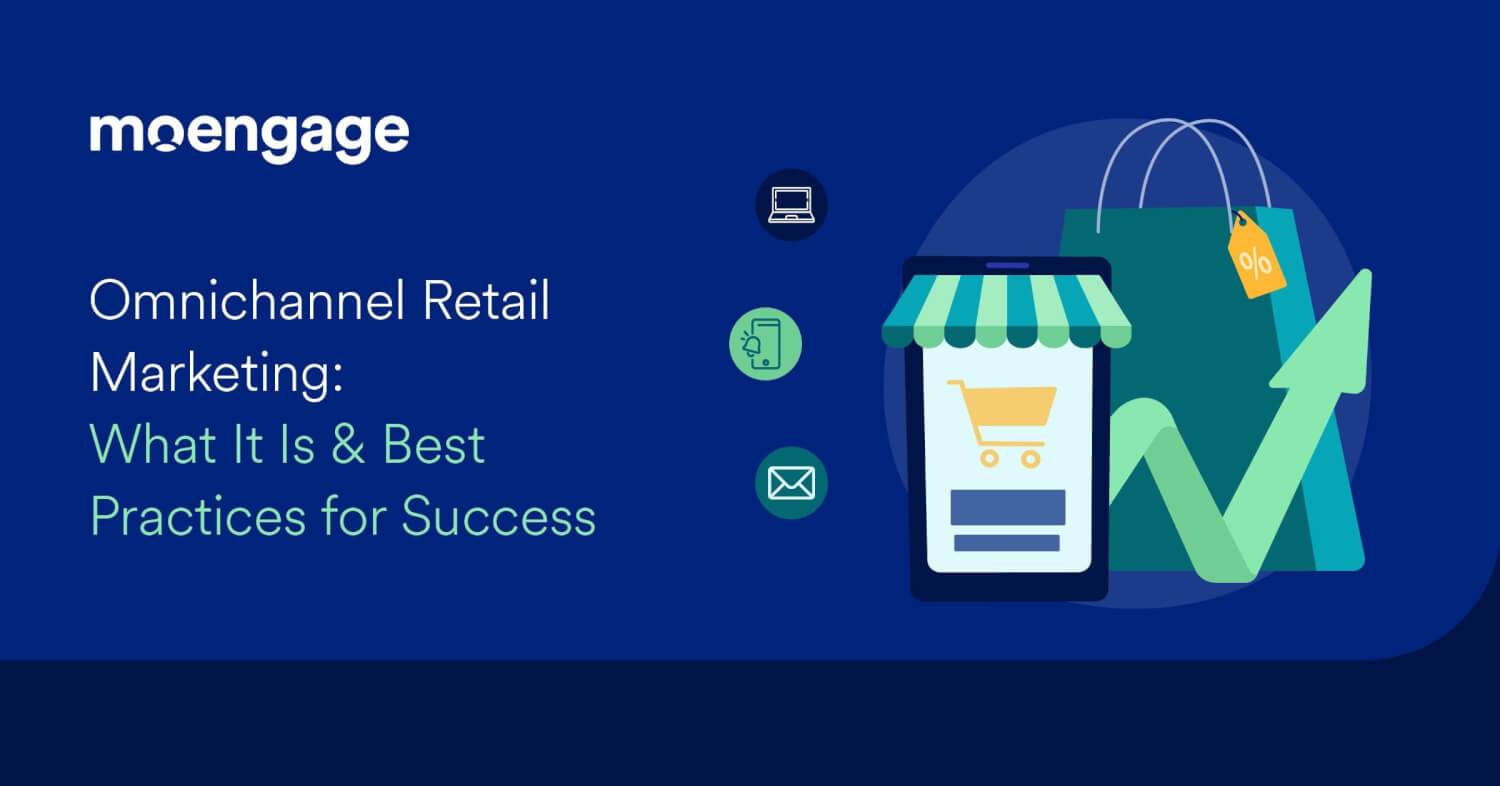
Reading Time: 11 minutes
Omnichannel retail marketing (i.e., omnichannel retailing) involves keeping customers at the heart of the equation and engaging them differently on various channels based on their stage in the customer lifecycle.
As humans, we enjoy having alternatives and choices. This is particularly true when it comes to shopping. According to a report by enVista Retail Market Research, consumers prefer to shop across a variety of channels rather than sticking to one. Savvy shoppers explore multiple products — and brands — to find what they are looking for. Omnichannel marketing encourages a seamless retail experience at every customer touch point to ensure customers recognize your brand no matter how they connect with you.
All of this translates into greater customer engagement, which helps retailers meet their bottom line — increased conversions, average order values (AOV), customer lifetime value (LTV), and revenue.
This guide helps retailers reach customers at the right time and on the right channel by covering omnichannel retail marketing, why it’s important, and best practices to follow. To begin exploring omnichannel marketing in retail, we have to consider and prioritize the customer experience journey itself.
What is Omnichannel Retail Marketing?
Omnichannel retail marketing is a customer engagement strategy that provides customers with a seamless, consistent, and familiar customer experience across all channels and touchpoints. It leverages customer data to deliver personalized messaging in-store, on the web, and in apps.
Marketers know that consumers’ attention isn’t in a single place; it’s spread across a myriad of online and offline channels, from in-store to billboards to web, and even mobile. Retailers looking to foster strong, meaningful relationships with customers need to develop an omnichannel strategy that ensures customers feel appreciated and understood. At the end of the day, this is what drives conversions, brand loyalty, and even advocacy.
Retail brands need to recognize that to retain their current customers and attract new ones, they must provide an unrivaled shopping experience across all channels, including digital channels and their brick-and-mortar store (i.e. if they have one).
Being present at the different touchpoints of a customer’s buying journey is critical to a brand’s success. To do that, brands should know the customer’s needs, wants, and preferences.
This is where a unified, 360-degree customer view across digital and offline channels is essential, especially for implementing a successful omnichannel strategy.
Is using multiple channels the same as having an Omnichannel Retail Marketing strategy though?
Absolutely not! But, we often do see most brands confuse omnichannel with multichannel marketing.
Omnichannel vs Multichannel in Retail: The Main Differences
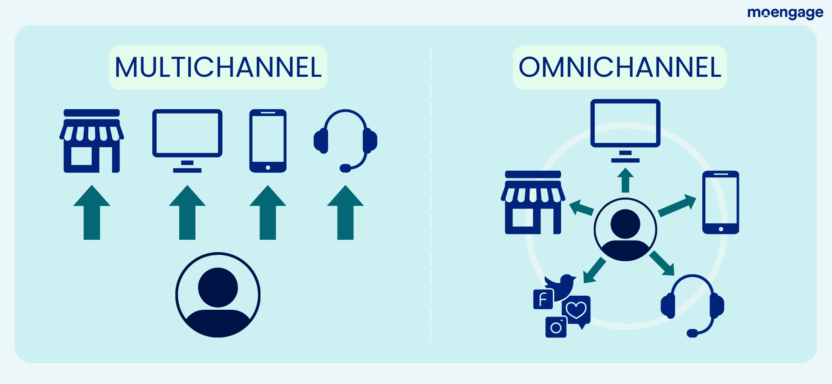
It’s easy—and common—for brands to think multichannel and omnichannel are the same thing. While they are both focused on ensuring customers have the ability to engage with your brand through a wide range of channels, one is far more successful than the other in developing a customer-centric approach and driving authentic customer engagement.
- Multichannel retailing: Customers interact with your brand through various disconnected channels that lack uniformity and provide a disjointed and unfamiliar experience for your customers.
- Omnichannel retailing: Customers interact with your brand through various interconnected channels that provide customers with a standard, uniform, and familiar experience across all customer touchpoints.
Omnichannel marketing stands apart from multichannel marketing by enabling brands to adopt a customer-centric approach. It involves creating an experience that revolves around the visitors and their specific needs by ensuring that all channels are interconnected and integrated. This integration guarantees that customers enjoy a consistent and seamless experience across all channels.
Unlike multichannel marketing, omnichannel marketing provides marketers with a comprehensive understanding of their customers and their behavior, allowing them to gain a holistic picture of their target audience.
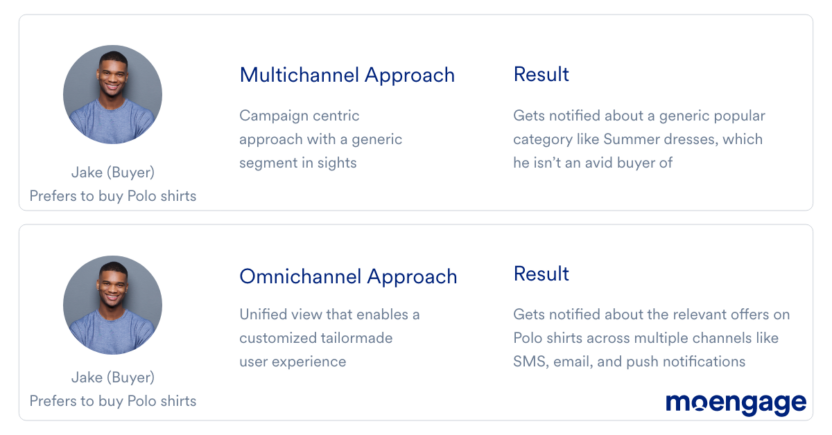
With omnichannel, the objective isn’t simply to offer as many channels to your visitors as possible, it’s about learning how different demographics engage with channels and leveraging these insights to inform how you connect with customers in the future to maximize engagement.
The fact is, customers shop in very different ways. Those who enjoy compassionate, one-on-one interactions with a salesperson at a brick-and-mortar location will likely rely on a more heavily orchestrated journey that guides them toward the products that are right for them. They’ll be more open to an online chatbot for a guided experience or mobile push notifications that keep them apprised of new products and timely deals.
While this strategy isn’t right for every customer, an omnichannel approach allows retail brands to curate a personalized experience by leveraging the channels that customer interacts with most. By building an experience around the customer, brands ensure a customer-centric approach that makes customers feel understood and appreciated.
Why Omnichannel is so Important for Retail Marketing
According to our Personalization Pulse Check, 48.1% of consumers are delighted with improved communication and experience. Modern consumers not only want a seamless, familiar experience across all touchpoints — they expect it as a minimum.
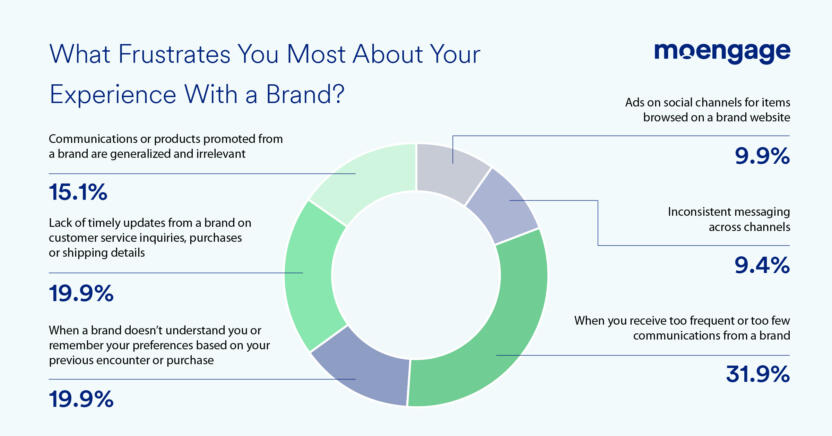
This means brands looking to maximize engagement need to deliver consistent messaging across all channels, provide personalized product and service recommendations, and remember (and account for) customer preferences based on previous activity.
Omnichannel data gives brands a more holistic, complete view of their customers, helping them truly understand their interests, preferences, and needs. An omnichannel approach also ensures that brands can meet customers where they are most likely to see the greatest engagement, drawing customers in and increasing brand interactions.
For example, when a customer abandons a cart, an omnichannel strategy not only empowers marketers to better understand why the customer may have abandoned their order, but also allows them to react meaningfully, regardless of the reason. This helps marketers to optimize engagement by sending follow-up communication via the right channel at the optimal time, and increases the likelihood that they will make a purchase.
When done properly, omnichannel marketing can funnel customers closer to conversions, repeat purchases, and deepen brand loyalty.
Common Channels Used for Omnichannel Retail Marketing
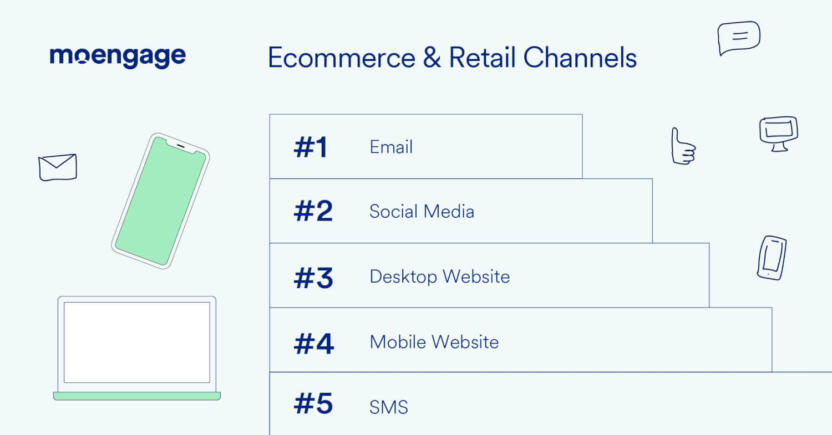
Modern consumers have an array of channels at their disposal — but that means retailers do too.
The trick is to perfect your omnichannel presence so that you can reach customers on their preferred channel with the right message at the optimal time. This will drive customer engagement, leading to more (and higher-value) conversions.
Below, we cover the top channels retailers need to incorporate into their omnichannel marketing strategy and look at how brands can leverage these channels to maximize engagement.
Every consumer has an email — after all, it’s how modern consumers connect to online accounts from video subscriptions to banking. This makes email, based solely on its outreach potential, the most commonly used marketing channel by B2C retailers.
The challenge is that your customers subscribe to a lot of different email lists, and it’s increasingly challenging to cut through the noise and make sure your messages are the ones that are read.
Inundated with a barrage of product recommendations, promotions, and messages, customers seek brands that truly understand them. Lack of personalization is the kiss of death for an omnichannel strategy, as it’s unlikely that customers will engage or respond to generic content.
Teams looking to maximize the impact of email should personalize their email content for better engagement: recommend unique products that aren’t just based on the season but instead informed by customer interests; send targeted promotions that a customer cares about instead of meaningless offers they’ll never use; and give customers meaningful product updates based on what they use.
Leverage customer data to optimize the timing of your campaigns, the type of email you’re sending, and the content (from subject line to copy text). Develop true brand loyalty by proving that your customers mean more to your brand than the item they left in their cart.
| Eliminate the need to code emails from scratch. MoEngage allows teams to intuitively create engaging email campaigns effortlessly and quickly without any coding experience. |
Social Media
Social media marketing can drive growth, create buzz, garner attention, and reinforce brand loyalty. It’s also becoming a popular method of direct marketing, with 70% of shoppers using Instagram for their next purchase. Whether it’s for direct sale or product discovery, modern customers are turning to social media when making their choice.
Social media platforms are windows to all the other access points of your marketing. Effective marketers can use social media marketing to generate leads at the top of the funnel, channeling this attention and converting it into mailing list subscriptions, app downloads, subscriptions, conversions, and repeat purchases.
| Meta Ads and Google Ads incorporate seamlessly into the MoEngage platform interface. This allows marketers to re-target and re-engage with their customers on their preferred platforms. |
Website Personalization
Typically, your website is the foundation of your entire digital experience, making it a core element of any omnichannel retail strategy. Whether on web or mobile, your website is an essential channel for regular engagement and repeat conversions.
Before becoming recurring, loyal customers, most consumers start out as visitors, with your website being a common early point of contact. This sets the tone for how your brand is perceived and is the gateway that encourages these visitors to adopt your services by downloading your app, opting into messaging, or enabling push notifications.
This all starts by ensuring customers end up on a responsive, dynamic landing page that is personalized based on the customer needs and streamlined to offer a familiar experience no matter where the customer connects. Be sure to A/B test the performance of your website’s landing pages and marketing campaigns to further optimize the retail experience and maximize engagement.
| MoEngage helps teams turn their vision into a reality in just minutes using our no-code “What You See Is What You Get” WYSIWYG editor. |
Mobile Website
Mobile access is critical to omnichannel marketing. Phones are an anytime and anywhere gateway between your customers and your brand. And while your mobile experience will certainly be different from your web experience, it still needs to have the same look and feel. After all, it needs to be recognizable and familiar to the customer to create a seamless experience when customers visit via mobile devices.
Mobile websites need to load well, function smoothly, and provide the customer with all the same opportunities that they would get on desktop or through a native app for the omnichannel experience to remain seamless.
SMS Messages
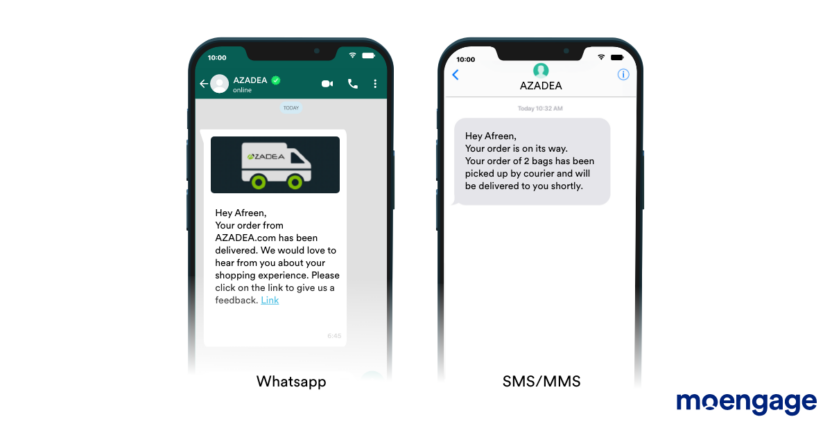
Customers are uniquely reactive to text messages: they’re quick to open and read them. In fact, SMS messages have the highest open rates among all of these channels. According to SlickText, this can be as high as 98%, dwarfing the open rates of even the most successful other channels.
Brands that effectively leverage SMS as part of their omnichannel retail marketing strategy have a better chance of having their marketing messages seen and engaged with. Increase conversions by using smart triggers that send personalized messages that reconnect customers with recently abandoned carts, promote relevant cross-selling opportunities, and entice customers to take advantage of a limited-time offer.
Improve the customer experience by creating automated sequences that confirm their order, notify customers of any changes to their order status, and request feedback about their experience.
| On average, MoEngage customers double their use of SMS– making it their preferred engagement channel. As a more far-reaching alternative to SMS, MoEngage also has the option of Whatsapp Native, which opens up new opportunities to make messages richer and more dynamic with a reliable display of images, GIFs, videos, and graphics. |
Omnichannel Retail Best Practices to Follow
For an optimized omnichannel retail strategy, the priority is delivering a seamless and immersive brand experience that customers love and want to engage with. But delivering this consistently is more challenging than it seems. Below, we cover the three best practices to follow when executing an omnichannel retail strategy using a customer engagement platform (CEP).
The Insights-Led Approach
It’s impossible to put customers at the center of their retail experience without understanding what they want in a product or brand. Accumulating high-quality data allows a brand to put customer needs at the forefront of its marketing strategy.
MoEngage works with several Customer Data Platforms (CDPs) that are leaders in the ecosystem like Tealium, Segment, mParticle, and Eucloid to drive this constant cycle of data oscillation that helps create an efficient engagement dynamic between brands and their customers while also ensuring that the data is secure and protected.
This level of depth enables you to power an omnichannel retail strategy that delivers hyper-personalized messaging, allowing you to truly understand and connect with customers.
Tailoring the Customer Experience
Competition for customer attention is fiercer than ever before. The modern customer understands their wealth of choice and, expects an intuitive, personalized experience to win their favor.
For omnichannel retailers, this means ensuring that the customer experience is uniform and integrated, so customers get a familiar, seamless experience they expect and love. Ensuring that the experience is recognizable across all touchpoints keeps customers satisfied no matter how they connect with your brand.
Customer needs are met in real-time by using customer priorities to influence personalized campaigns. Synchronizing the brand’s offerings with customer desires directly affects their propensity to buy (as well as how much they spend).
Customer Engagement Platforms (CEP)
One of the best ways to optimize the performance of your omnichannel retail marketing strategy is by relying on a top-notch enterprise customer engagement platform (CEP) that helps your team automate marketing campaigns across channels and deliver hyper-personalized messaging that resonates with your visitors.
CEPs give retailers a single system to manage their omnichannel campaigns, from development to creation to implementation. It also provides more complete, rich data about users that can inform future marketing campaigns, allowing you to improve with each iteration. This empowers retail brands to create a cohesive customer experience across all channels and develop campaigns that leverage these interconnected channels for greater engagement.
Using a CEP makes it easier for retailers to implement an omnichannel marketing strategy by providing deep customer insights in a single space so teams can determine clear, actionable next steps for optimizing their marketing campaigns.
How to Execute a Good Omnichannel Customer Experience
But how do you know whether your marketing efforts are on the right track? These are five crucial indicators of a winning omnichannel customer experience:
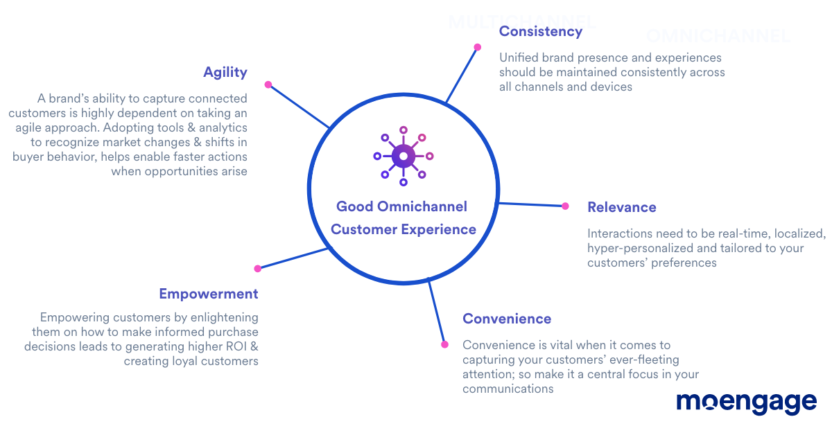
Agility
Customer needs, preferences, and habits are constantly shifting. To maintain a top-notch experience, brands need a customer experience that changes with them. An effective omnichannel strategy should be agile, enabling brands to adapt quickly to changing behavior and trends.
Consistency
The key to any omnichannel strategy is consistency. Customers not only want — but expect — a familiar, seamless experience across channels. Ensure your tone, branding, and entire experience are standardized across all channels so that the experience looks and feels familiar no matter how your customers connect.
Relevance
Recommendations, offers, and overall communication need to be relevant to customers for it to really resonate with them. Provide both contextually and temporally relevant offers by providing localized, hyper-personalized communication in real-time based on customer activity and behavior.
Convenience
Modern retail consumers are looking for fast, efficient services that make their lives easier, making convenience a vital element for achieving omnichannel retail success. Effective omnichannel strategies don’t just help you sell, they give customers a simple-to-use, intuitive, and convenient experience for customers.
Empowerment
When used properly, an omnichannel strategy supports and empowers customer experiences that your shoppers love. This allows retailers to connect with customers meaningfully, driving significant engagement and fostering deep brand loyalty.
Elevate Your Retail Omnichannel Strategy With MoEngage
Omnichannel retail marketing means far more than simply leveraging as many channels as you can simultaneously. It means treating all of these interconnected channels as part of a single, cohesive omnichannel communication machine.
The result is a customer-centric strategy that allows your brand to connect with customers on their preferred channels, allowing you to build deeper, more meaningful, and longer-lasting relationships with your customers.
A customer engagement platform (CEP) allows retailers to quickly build new campaigns that leverage all available channels and automatically optimize these campaigns to maximize engagement. They provide customer segmentation and behavioral data to help you craft hyper-personalized experiences and product recommendations that drive sales and develop brand loyalty.
Here at MoEngage, we empower retailers to develop strong relationships by prioritizing the customer and building omnichannel experiences centered around the customer and their shopping habits.
Schedule a demo to learn how to keep in step with your customers no matter where they are in their buying journey.











